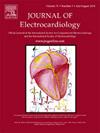阵发性和慢性心房颤动的 F 波摇摆
IF 1.3
4区 医学
Q3 CARDIAC & CARDIOVASCULAR SYSTEMS
引用次数: 0
摘要
矢量心动图(VCG)可以评估心电波的矢量回路,是心脏矢量在三个正交导联中的时空表示。心房颤动(AF)时,F波反映心房无序去极化,取代有序P波。通常,阵发性房颤(PAF)与慢性房颤(CAF)不同,可能是由于p波矢量环的主方向仍然保留。为了验证这一假设,本研究旨在评估受PAF和CAF影响的受试者的p波矢量环和f波矢量摆动的相似性。总的来说,10名正常窦性心律的健康(HEA)受试者,10名受PAF影响的受试者(1名在正常窦性心律期间,1名在AF期间)和10名受CAF影响的受试者获得了10-s VCG。采用ECGdeli软件提取P波,QRST对消后提取F波。椭圆轴和偏心率分别计算为VCG分量的均方根和轴间比值。总的来说,HEA 84次,PAF 205次(正常窦性心律89次,颤动116次),CAF 103次。PAF轴线和偏心率的分布与正常窦性心律无统计学差异(p值>;0.05),但与CAF Z轴相关的特征比PAF低(p值< 10−3)。房颤f波矢量摆动与p波矢量环相似,提示自终止房颤患者心房去极化主方向维持,且f波矢量摆动在房颤中比在房颤中更为明显。本文章由计算机程序翻译,如有差异,请以英文原文为准。
F-wave sway in paroxysmal and chronic atrial fibrillation
Vectorcardiography (VCG) can evaluate the vector loops of electrocardiographic waves, being a time-spatial representation of the heart vector into the three orthonormal leads. During atrial fibrillation (AF), F waves reflect the disorganized depolarization of the atria, replacing the organized P wave. Usually, paroxysmal AF (PAF) spontaneously terminates, differently from chronic AF (CAF), possibly due to the still-preserved main direction of the P-wave vector loop. To investigate this hypothesis, this study aims to evaluate the similarities between the P-wave vector loop and F-wave vector sway in subjects affected by PAF and CAF. Overall, 10-s VCG were acquired from 10 healthy (HEA) subjects showing normal sinus rhythm, 10 subjects affected by PAF (one during normal sinus rhythm and one during AF), and 10 subjects affected by CAF. P waves were extracted using ECGdeli software, while F waves were extracted after QRST cancellation. Ellipse axes and eccentricities were calculated as the root mean square of VCG components and the ratio between axes, respectively. Overall, 84 beats of HEA, 205 beats of PAF (89 beats during normal sinus rhythm and 116 during fibrillation), and 103 beats of CAF were analyzed. Distributions of axes and eccentricities of PAF are not statistically different (P-value>0.05) than normal sinus rhythm but features related to the Z axis of CAF were statistically lower than PAF (P-value〈10−3). F-wave vector sway in PAF resembles the P-wave vector loop, suggesting the maintenance of the atrial depolarization main direction in subjects with self-terminating AF. Moreover, the F-wave vector sway is more manifest in PAF than in CAF.
求助全文
通过发布文献求助,成功后即可免费获取论文全文。
去求助
来源期刊

Journal of electrocardiology
医学-心血管系统
CiteScore
2.70
自引率
7.70%
发文量
152
审稿时长
38 days
期刊介绍:
The Journal of Electrocardiology is devoted exclusively to clinical and experimental studies of the electrical activities of the heart. It seeks to contribute significantly to the accuracy of diagnosis and prognosis and the effective treatment, prevention, or delay of heart disease. Editorial contents include electrocardiography, vectorcardiography, arrhythmias, membrane action potential, cardiac pacing, monitoring defibrillation, instrumentation, drug effects, and computer applications.
 求助内容:
求助内容: 应助结果提醒方式:
应助结果提醒方式:


